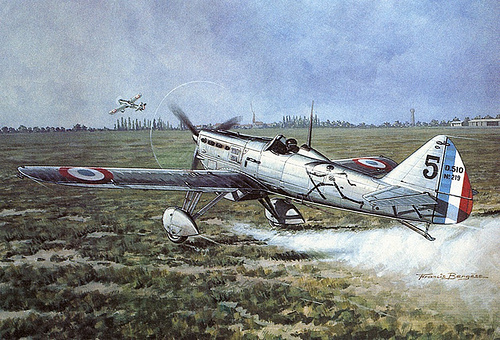The Dewoitine 500 series represented the most modern, technically ambitious fighters of their day. They marked a transition phase between open-cockpit biplanes of the 1920s and the more modern aircraft of World War II.
In 1930 the French Aeronautique Militaire issued specifications for a new fighter to replace the aging Nieuport-Delage ND 62s then deployed. It fell upon designer Emile Dewoitine to conceive a revolutionary new concept that spelled the beginning of the end for biplanes. First flown in 1932, the Dewoitine 500 exuded modernity. It was a cantilevered, low-wing monoplane constructed entirely of metal. The craft was covered by stressed metal sheeting and completely devoid of drag-inducing struts and bracing wires. The only seemingly antiquated feature was fixed landing gear with conspicuous oblong spats. The in-line engine was closely covered by a pointed cowl, giving the craft an ultramodern, very sleek appearance. In the air, the Dewoitine was faster than its biplane contemporaries, more maneuverable, and, because of its metal construction, much stronger. The Armee de l’Air was duly impressed by the new machine, and it entered production in 1933. Within two years a total of 143 were built, including a number of cannon-armed Model 501s.
In August 1934 Dewoitine fielded a more refined version, the Model 510. It mounted a larger rudder, an uprated engine, and other aerodynamic refinements. Consequently, it became the first French fighter to exceed 250 miles per hour in level flight. The French air service acquired an additional 120 of these sleek machines, with a further 30 being assigned to the Navy’s Aviation Maritime (naval air arm). These craft also caught the attention of several governments and were exported abroad, with China acquiring 24 D 510s, Lithuania 14. The Dewoitine series still equipped several frontline units as late as 1940, at which time they had been overtaken and rendered obsolete by the newer Messerschmitt Bf 109. Nonetheless, the D 500 series made history by anticipating modern design trends by several years.
Specifications (D.510)
General characteristics
Crew: 1
Length: 7.94 m (26 ft 1 in)
Wingspan: 12.09 m (39 ft 8 in)
Height: 2.42 m (7 ft 11 in)
Wing area: 16.50 m² (177.61 ft²)
Empty weight: 1,496 kg (3,298 lb)
Loaded weight: 1,929 kg (4,253 lb)
Powerplant: 1 × Hispano-Suiza 12Ycrs V12 engine, 640 kW (860 hp)
Performance
Maximum speed: 402 km/h (217 kn, 250 mph) at 5,000 m (16,405 ft)
Range: 700 km (380 nmi, 435 mi)
Service ceiling: 11,000 m (36,090 ft)
Rate of climb: 14.85 m/s (9,600 ft/min)
Wing loading: 117 kg/m² (23.9 lb/ft²)
Power/mass: 330 W/kg (0.20 hp/lb)
Time to altitude: 1.32 min to 1000 m (3,280 ft)
Armament
Guns: 1 × 20 mm Hispano-Suiza HS.9 cannon, 60 rounds
2 × 7.5 mm (.295 in) MAC 1934 machine guns, 300 rpg
Variants
D.500.01
First prototype aircraft.
D.500
First production version with Hispano-Suiza 12Xbrs engine with 515 kW (690 hp), armed with 2 × 7.7 mm (.303 in) Vickers machine guns or 2 × 7.5 mm (.295 in) Darne machine guns in the nose, provision for 2 × additional Darnes in the wings. 101 built.
D.501
Re-engined with Hispano-Suiza 12Xcrs engine, armed with a 20 mm Hispano-Suiza S7 cannon between the engine cylinder banks firing through the propeller hub and 2 × wing-mounted machine guns. 157 built.
D.503
The sole D.511 prototype fitted with a 12Xcrs engine with a circular radiator in the nose, the same armament as D.501. First flight 15 April 1935, found to perform worse than D.500. The aircraft was briefly the personal mount of René Fonck.
D.510
Re-engined with Hispano-Suiza 12Ycrs producing 640 kW (860 hp), armed with a 20 mm Hispano cannon and 2 × 7.5 mm (.295 in) MAC 1934 machine guns in the wings. First flight 14 August 1934, 120 built.
D.511
Prototype with D.500 fuselage and tail, smaller wings, cantilever undercarriage, 12Ycrs engine. One prototype built in 1934 but never flown, converted to D.503.
AXD1
The short designation for the single Dewoitine D.510 supplied to the Imperial Japanese Navy Air Service for evaluation in 1935.
Dewoitine Navy Type D Carrier Fighter
Long service designation for the D.510 supplied to the IJNAS in 1935
